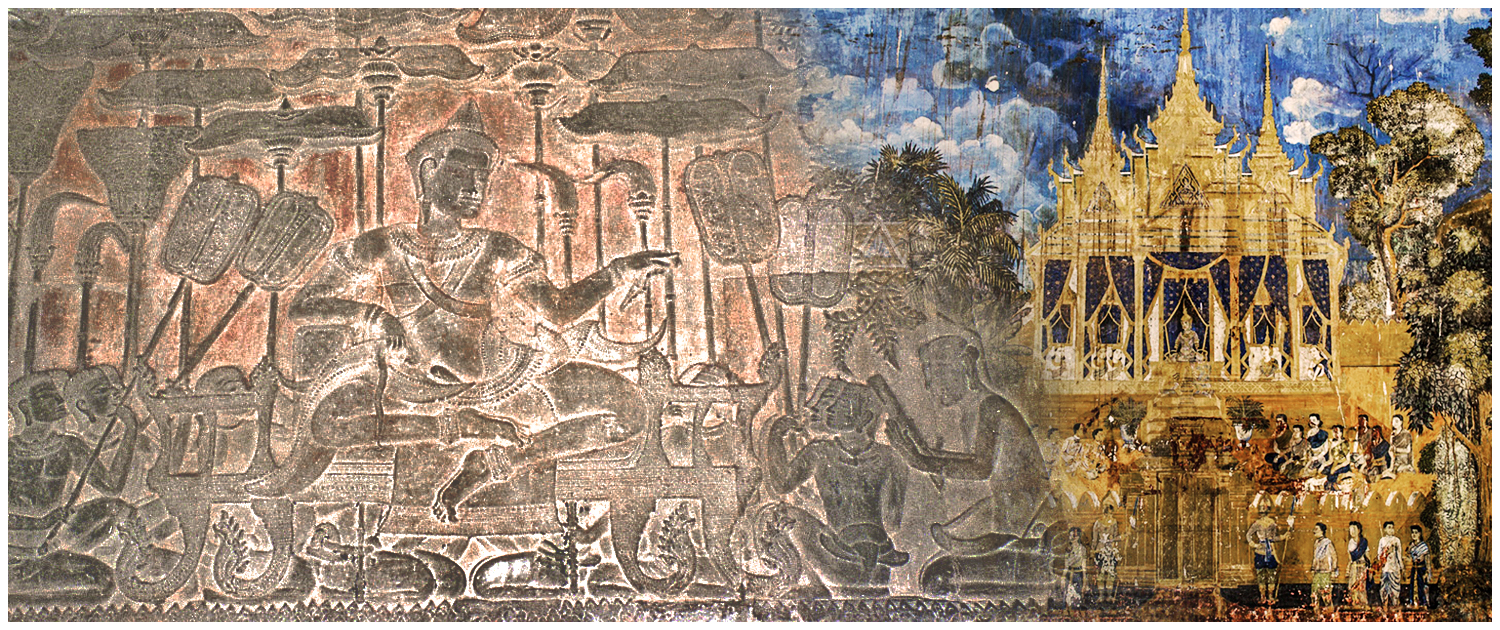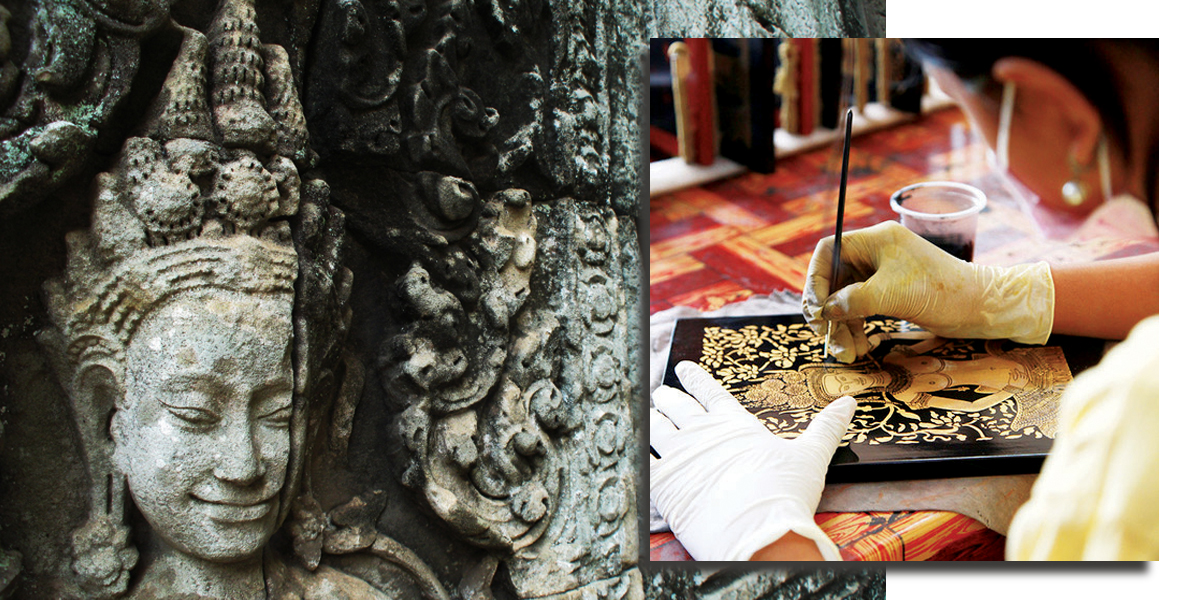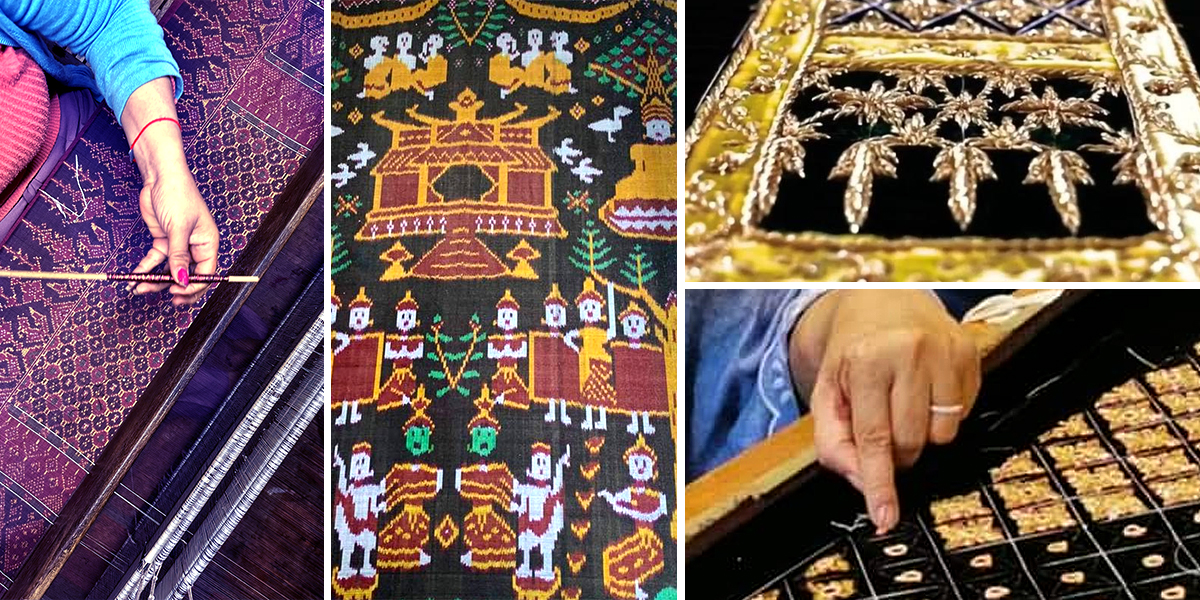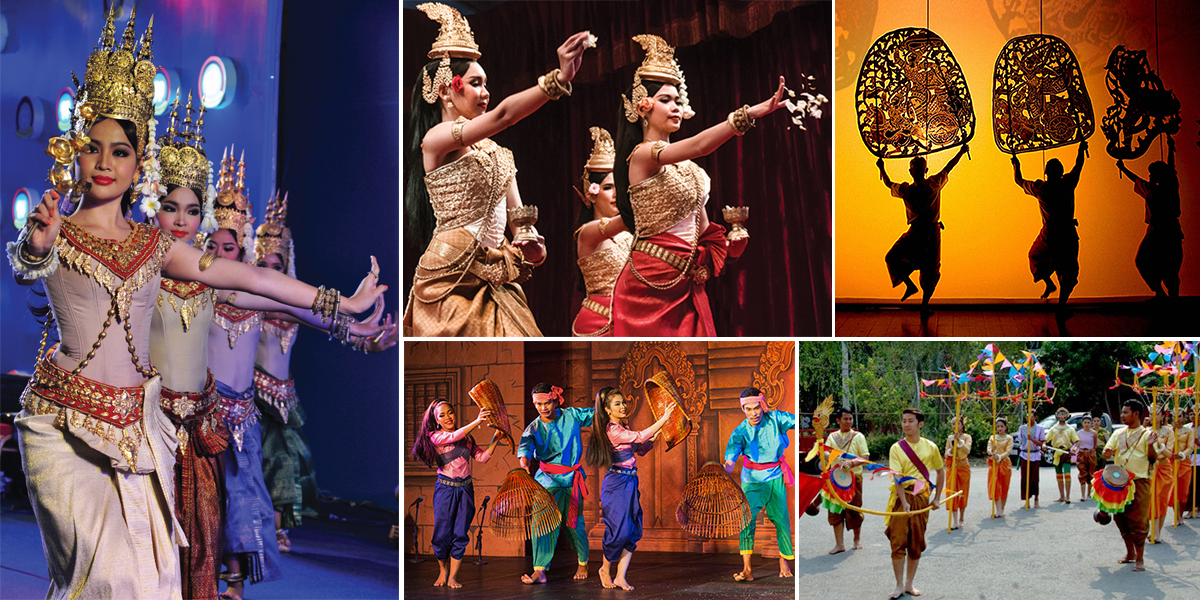Arts & crafts
Traditional Cambodian arts and crafts including silk weaving, silverwork, stone carving, wood carving, lacquerware, pottery, ceramics, temple murals, basketry and copper-art, have evolved from ancient times.
A tradition of modern art began in Cambodia in the mid-twentieth century. The contemporary visual arts scene in Cambodia has experienced an artistic escalation.
Many farmers have expanded to weave baskets, make pots, and breed silk worms to produce silk for weaving. In recent years, more sculptors and painters have surfaced to produce marvellous pieces for tourists to take home. Silk weaving in Cambodia has a long history. The practice dates to as early as the third century when textiles were used in trade. Modern textile production skilfully mimics these historic antecedents and produce beautiful motifs that echo clothing details on ancient stone sculptures. By tourists’ demand, skill workers are producing silverwork in the forms of jewellery, souvenir items, especially boxes adorned with fruit and Angkor-inspired motifs. Usually the men produce most of the forms for such work and the women complete the intricate filigree.
Efforts to restore Angkor resulted in a new demand for skilled stone carvers to replace missing or damaged pieces and from that, a new tradition of stone carving has risen in recent years. While some carvings remain traditional-style, some carvers have been successfully producing contemporary design to satisfy market demands.
The village of Koh Anlong Chen (Chinese Island) on the Tonle Sap and the province of Kandal are especially renowned for skilled copper artisans. Their skill has been passed down from generation to generation. These craftsmen cut and carve flattened copper into decorative art pieces. Pots, bowls, plates, ornamental swords, bracelets, and other souvenir items are crafted from flattened copper. While copper decorative swords are popular for Khmer weddings, copper-made decorative pots and bracelets are popular tourist souvenirs.
There are many shops in the city that offer these copper souvenirs. In fact, for a meaningful choice, there are classes here in Cambodia that conduct lessons on how to craft your very own jewelry. These classes usually last only a few hours and all equipment and materials are conveniently included. Khmer artists are always keen to impart their skills to visitors.
Cambodia produces one of the finest silk fabrics in the world. Woven exclusively from Mulberry Silk, the purest form of silk extracted from farmed yellow Silkworms, Cambodian silk fabrics were once used only by royals or for official use.
Souvenir is an important component of the tourist experience. Bringing back mementos and souvenirs remind one of special moments in your life. Whether to share a piece of those memories with friends or family back home or hold memories of those special moments, the choice of a meaningful souvenir is important.
Taking home a piece or two of these fine pieces of art as souvenir help perpetuate special moments; these are all good conversational wonders.
Khmer Classical Dance
The Khmer Classical Dance or Robam Preah Reach Trop (The Royal Ballet), is Cambodia’s premier performing art form; a highly stylized dance form originated from the royal courts, performed and maintained by attendants of the royal palaces.
Two of the most performed classical dances are the Robam Chuon Por (Blessing dance) and the Robam Tep Apsara (Apsara Dance). These performances feature elaborately costumed dancers performing slow and figurative gestures to the musical accompaniment of a traditional musical ensemble.
Proof that this delicate dance form existed as early as the 7th century can be seen in carvings at Sambor Prei Kuk temples in Kampong Thom province, where these ethereal beings (Apsaras), have been immortalised in stone. Hundreds of Bas-reliefs depicting Apsaras can also be seen in the Angkor temple complex.
As evidenced by those carvings, Apsara dance has in fact been part of the Khmer culture for more than a millennium and is an essential part of the culture. According to Hindu mythology, Apsaras were beautiful female creatures that descended from heaven to entertain Gods and Kings with their dance and for centuries, the delights of Cambodia’s celestial Apsara dancers were a treat reserved for royalty and the gods.
This dance form was first introduced to foreign countries during the 1960s as the Khmer Royal Ballet and became widely celebrated as iconic of Cambodian culture, often performed during public events, holidays, and for tourists visiting Cambodia. Cambodian girls are trained from a very young age to acquire the flexibility required for executing intricate movements; some of which demand the ability to bend their fingers almost to their wrists. Every single movement of their fingers and every step they take, have a particular meaning.
A visit to Cambodia is only complete when one has attended at least one such traditional dance performance.
Khmer classical dance includes also the Lakhon Khol, a traditional Mask theatre having its origins from the Angkor period. From inscriptions left at the Sambor Prei Kuk temple in Kampong Thom, it is believed to have begun sometime in the 10th century during the reign of King Jayavarman V.
The Lakhon Khol theatre is a sacred dance form with religious values depicting the Reamker, a Cambodian epic poem based on the Sanskrit’s Ramayana epic. Performers put on masks to assume the characters in the poem.
The earliest mention of this epic’s manuscript in Cambodia dates back to the 7th century as revealed by the Veal Kantel inscriptions found in Stueng Treng province while the earliest record of the mask dance is believed to have begun in the 10th century during the reign of King Jayavarman V, according to an inscription at Sambor Prei Kuk temple in Kampong Thom province.
Reamker adapts the Hindu ideas to Buddhist themes and shows the balance of good and evil in the world and has become the mainstay of the royal ballet’s repertoire. Classics like Robam Hanuman and Sovann Maccha are also derived from the Reamker,
Lakhon Khol Characters are portrayed through 4 colour mask forms; green for Rama, a majour deity and the central figure of the ancient epic; yellow for Lakshmana, the younger brother who assists in rescuing Sita from Ravana, the red one, and white for Hanuman, commander of the monkeys.
The Lakhon Khol Wat Svay Andet” theatre plays for the divinities of divisions, such as Reamker and some other things.” Later, there was a Giant with Hanuman statue iconic Lakhon Khol In Phnom Penh in 1954, after independence from France, but the statue lost and instead the Chuon Nath statue still remains.
Another specific story of the theatrical performance is the Reamker, the Khmer legend of the Ramayana. The performance includes an introduction to storytellers who play an important role in the performance and classical music of the Pin Peat.
Khmer Shadow Theatre
Sbek Thom shadow theatre has its roots steeped deep in Khmer history. This ancient art of shadow puppetry is in fact a sacred tradition that dates back to pre-Angkorian times as evidenced by bas-reliefs left at the 7th century Sambor Prei Kuk temple.
This art form was almost wiped out during the Khmer Rouge era when the majority of the country’s intellects and artists were targeted and executed. The Sbek Thom shadow art like most of all the Khmer art forms enjoy resurgence only in recent decades. The two surviving genres of shadow puppetry are sbek thom and sbek thoch; both of these apply shadows of leather puppets projected on a white screen to retell age-old tales and entertain.
A large white cloth (Screen) is propped up by bamboo poles and a fire is lit from behind to produce the shadows on the screen that the audience sees. throughout the show. A Khmer orchestra, a pinpeat, plays traditional Cambodian music while two narrators tell the story. These shows are usually staged at night in an outdoor setting to ensure the shadows are at their finest.
This tradition has been kept popular largely by the villagers in Siem Reap, where performances took place in paddy fields or at pagodas where they are traditionally dedicated to the divinities and staged only on auspicious occasions three or four times a year; on occasions such as Khmer New Year or the King’s birthday, etc.
Nowadays, the once rigidly sacred Sbek Thom transitioned into a recognised secular art form commonly performed across the country for entertainment; shows became much more numerous. However, while this ritualistic dimension of shadow puppetry may have dwindled, the ceremonial elements remained, enshrining the importance of Sbek Thom in Khmer history for many decades to come.
Today, rituals must still be carried out when hand-carving the puppets used for the performances. The meticulous carving process can take up to 20 days. While cutting the characters used for the show, artists must wear white, abstain from alcohol and observe a sin-free life. The leather used must also come from cows that have died of natural causes and not the ones that are slaughtered. The hides are coloured with dye from Kandaol tree bark, with artists drawing each figure onto the tanned leather before cutting them out and painting them. The bamboo poles that are attached for the performers to handle, must be ritualistically cleansed.
The same rituals are observed when making the Sbek Touch puppets The difference between these two genres, Sbek Thom (Big) and Sbek Touch (Small) is not only in their sizes, but their deployment in the stories. Sbek Thom puppets, made about 1.5m to 2m in size, are used to feature stories from the Reamker. The Sbek Touch, the much smaller puppets with movable parts, tell a wide range of folk and funny stories of Cambodia›s countryside.
Sbek Thom lures people through an almost primeval attraction. The shifting shadows and intricate figures can captivate an audience for hours on end.
Folk Dance
The Kingdom of Cambodia has a wealth of traditional and cultural festivals dated according to the Cambodian lunar calendar. All of these festivals are influenced by the concepts of Buddhism, Hinduism, and royal cultures. The festivals, which serve as a source of great joy, merriment and Cambodia’s national colors, play a major role in influencing tourists’ opinions, behaviors, and options. Most of these are a time of great rejoicing for the predominantly rural and the urban populace. Nowadays the whole nation unites in understanding its cultural values and traditions. On these pages, are some of the important celebrations organized during the year.




